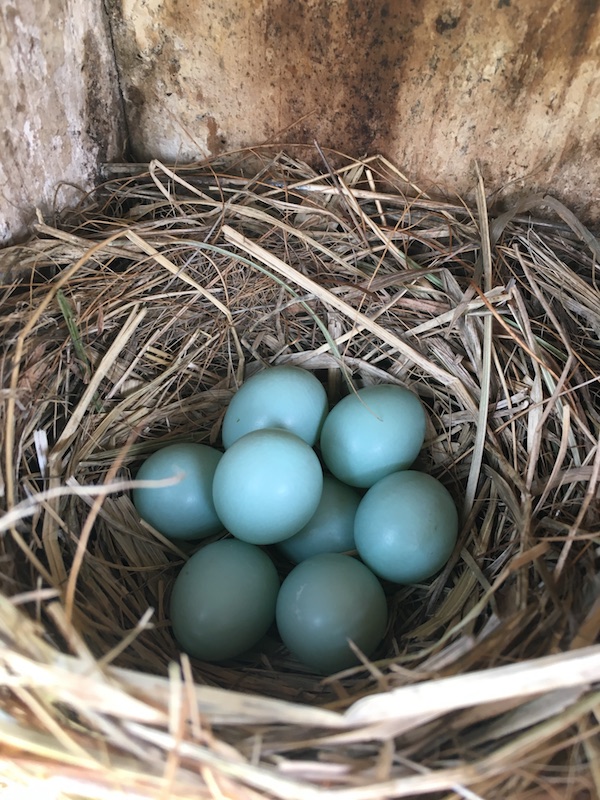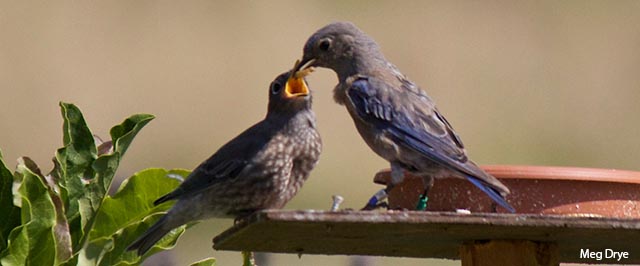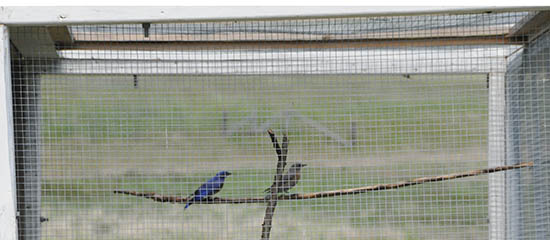Another season of the San Juan Islands Western Bluebird Reintroduction Project has come to a close. As with every season since the project began in 2007, this one had its ups and downs. Here are a few of the highlights:
- Our total bluebird population in the San Juan Islands grew, thanks to an infusion of three newly translocated families.
- We also saw a healthy hatch of youngsters emerge from the nesting boxes.
- We were pleasantly surprised when one family, feared lost, turned up over on Lopez Island—a first for the project.
- We also experienced some disappointments, with fewer returning adults than we’d hoped for, plus a sad midseason case of cat-inflicted mortality.

The year started with the return of six adults in late February—two females and four males. Of these returning bluebirds:
- three were born on San Juan Island last year,
- two were translocated to the island last year, and
- one was translocated to the island two years ago.
One pair of the returning birds established a nest on SJPT’s Red Mill Farm Preserve, conveniently located just outside our field office. Every morning as we arrived at the farm, we were greeted with the “phew phew phew” of a bluebird perched on the fence of the Salish Seeds Nursery.
Another pair was adventurous and decided to nest on Lopez Island. This was a first for the project, and likely was the first pair to nest on Lopez in several decades. They picked an idyllic nest box on the southwest part of the island.
We also had two bachelor males return. One of them tried his best to attract a female, picking out a nice territory with plenty of boxes to choose from and a wide grass lawn where the foraging was good. This little guy defended his territory from all challengers, such as tree swallows, house sparrows, and the like, for most of the summer. The other returning bachelor was more interested in roaming the island, popping up in different places during the season.

In an effort to boost our population and recover from the decline of 2012/2013, we completed three translocations this year, bringing a total of 18 new birds into the population. In each translocation, we brought a family group (an adult pair with nestlings) up from Joint Base Lewis McChord (JBLM) in South Puget Sound. JBLM has one of the largest intact Garry oak savannahs in the northwest, as well as a robust population of Western Bluebirds.
We held each of the translocated families in the aviaries for 4 or 5 days, until the nestlings fledged and were able to fly with confidence. At that point, we released them and did our best to track them.

Two of the three translocated pairs successfully re-nested shortly after release. One of these had a clutch of 6 eggs, and the other had a clutch of 5 eggs, all of which hatched. As is often the case, the older juveniles helped feed their nestling siblings, but surprisingly, our bachelor males showed up at one of the territories and helped out with the feeding (albeit on a two-for-me-one-for-you basis).
Our final population for the year is 33 or 34 birds between San Juan and Lopez Islands. Now, as the season is ending, the bluebirds are roaming around the islands, grazing on remaining insects before they head south for the winter. We wish them well and hope for a big return in the spring!

As a reminder, if you have nest boxes on your property, the breeding season is now behind us, so go ahead and pull out the nests inside. When our bluebirds return, they will be looking for clean boxes!
If you have any questions or comments, contact Rob Roy McGregor (robroy@sjpt.org or 360-317-1180) or Kathleen Foley (kathleenf@sjpt.org or 360-317-1180).
Thanks to our partner, Gary Slater at the Center for Natural Lands Management (cnlm.org), for his technical oversight of the project—and to you for your decade-long support of this effort!
